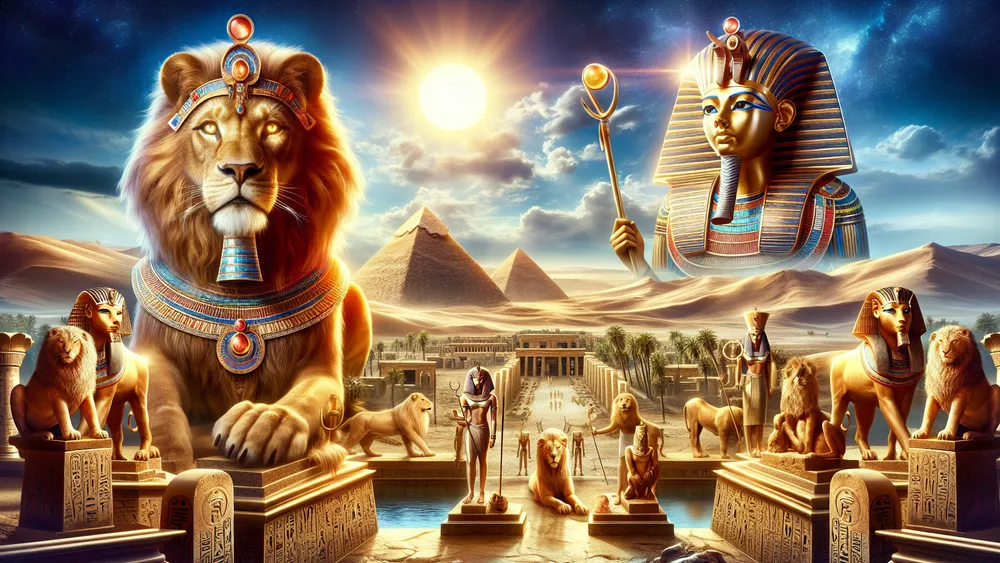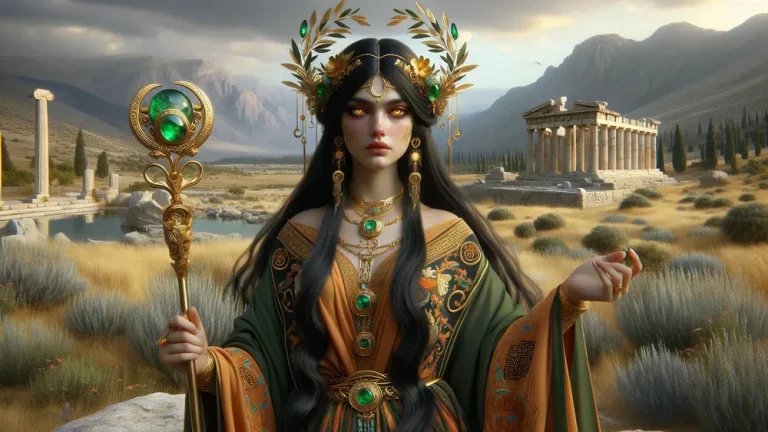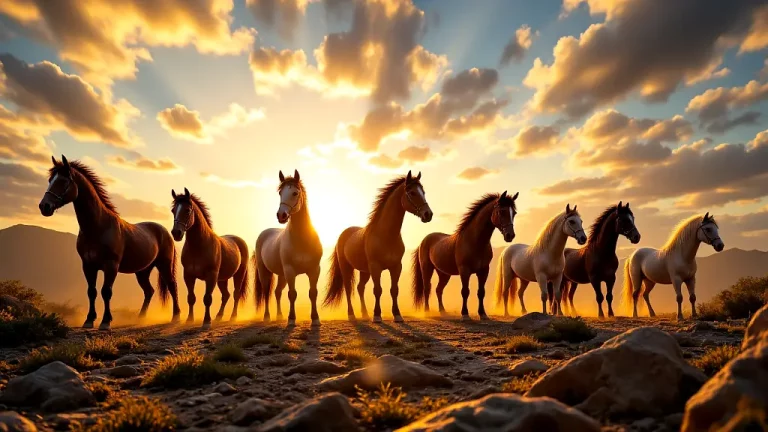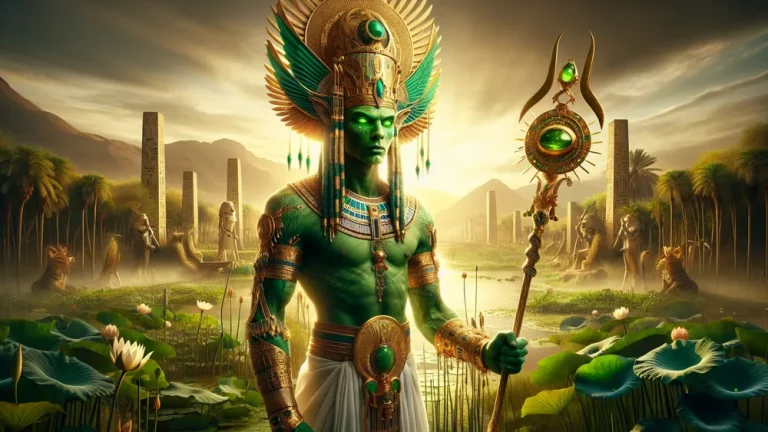The Significance Of Lions As A Symbol In Egyptian Mythology
In Egyptian mythology, symbols had a big part in showing ideas and beliefs. The lion is a very strong important symbol. Why did ancient Egyptians, who lived near the Nile, like an animal from the savannas? The lion was a symbol of strength, safety, and royal power.
Key Points:
- Lions in ancient Egypt symbolized power, protection, and royalty.
- Pharaohs used lion imagery to showcase their authority and divine right to rule.
- Lions were seen as guardians of both the physical and spiritual worlds.
- Gods like Sekhmet and Maahes, with lion attributes, represented different forms of power in Egyptian mythology.
- Lion symbolism in art and architecture reflected the pharaoh’s strength and control.
- Lions played a crucial role in Egyptian stories and myths, representing protection and divine forces.
- Ancient lion symbolism still influences modern Egyptian culture, representing strength, history, and leadership.
This blog will look at lion symbolism in ancient Egypt, how they were shown in art, buildings, and their stories. You will know a lot about why the lion was important in ancient Egypt.
Lions As A Symbol In Egyptian Mythology: Overview and Key Facts
| Key Point | Description |
|---|---|
| Power Symbol | Lions showed strength and dominance. Pharaohs used them to show their right to rule. |
| Guardians for Protection | Lions gave protection. They were thought to guard both real and spiritual worlds, often seen as guardians of holy places. |
| Royalty and Control | The lion’s majestic look was about the pharaohs’ authority and royal power, showing their divine ruler status. |
| Gods and Stories | Some gods had lion heads, like Sekhmet and Maahes, who were important in Egyptian mythology. They showed different kinds of power and protection. |
| Art and Buildings | Lions were in Egyptian art and buildings, from big statues like the Sphinx to detailed carvings in temples and tombs. |
| Cultural Meaning | The lion’s symbolism was in more than just myths. It affected cultural practices, religious actions, and art. |
How Lions Mattered in Ancient Egypt’s History
To see how lions were important in ancient Egyptian culture, we look at their parts in life, tales, and symbols of royalty.
Lions’ Role in Egyptian Life
In ancient Egyptian society, lions were seen as great and strong animals. Much like how a powerful person is viewed today, the Egyptians thought of lions as symbols of big power and authority. This respect was not just about their physical power but also their symbolic meanings. Lions were linked to the pharaohs.
The pharaohs were thought of as divine rulers, and lion pictures showed the pharaoh’s strength and protective nature over the people and land.
The meanings tied to lions were many. Power, protection, and royalty were part of it. For example, lions in art and buildings were seen as guards of holy places, like how gargoyles in Gothic buildings are thought to keep bad spirits away. In texts, lions were often talked about. They showed their protection and royal traits. Here are some examples of lion images:
- The Great Sphinx of Giza. It has a lion’s body and a human head, showing the pharaoh’s strength and wisdom.
- Lion statues. They are at the Temple of Karnak and guard the holy area.
- Art carvings and paintings. Found in tombs and temples, they show lions in protective and royal settings.
Lions in ancient Egyptian society symbolized power, protection, and royalty, often connected to the pharaohs as divine rulers and guardians of holy places.
Lion Gods in Egyptian Stories
In Egyptian myths, there were gods tied to lions, and each one showed different kinds of power and guarding. A big one is Sekhmet, the fierce lioness goddess of war and healing. She was thought to keep pharaohs safe in fights and could bring both sickness and cure.
Another important lion god is Maahes, the lion-headed god of war and protection, who was often seen as a guard of holy places. Tefnut, the lioness goddess of moisture and rain, had a big part in keeping nature balanced and was often linked to the life-giving parts of water.
These lion gods were main parts in many stories that showed their roles and traits. For example, Sekhmet is in the myth of the Eye of Ra, where she is sent by the sun god Ra to punish humans but is calmed down to stop total destruction. Maahes is shown in stories as a strong guard of the pharaoh and the temples, showing strength and watchfulness. Tefnut’s stories often talk about her role in keeping the world balanced and her link to the key parts of life. Here are some known myths and stories:
- The Destruction of Mankind, Sekhmet’s anger brings harm to humans.
- Stories about Maahes guarding the holy places and protecting the pharaoh.
- Tales of Tefnut’s part in making and keeping life through her control over moisture and rain.
Lions as Symbols of the Pharaohs
In old Egypt, the lion showed the pharaoh’s power and control. Just like how today some countries use, for example, the eagle to show strength and leadership, in Egypt it was the lion that showed the pharaoh’s power to rule and protect. The lion’s majestic and fearsome nature made it suited to represent the pharaoh’s ability to protect and govern.
This symbolism was deep in the culture, with the lion often shown beside the pharaoh in different forms of art and images to show their link to divine power and protection.
Lion imagery was common in royal pictures and artifacts. It was a constant reminder of the pharaoh’s strength and control. For example, lion statues and carvings were put at temple and palace entrances to symbolize the pharaoh’s role as a guardian. Also, things like thrones, jewelry, and ceremonial items often had lion designs to show the pharaoh’s regal status. Here is a table comparing different pharaohs with their lion symbols:
| Pharaoh | Lion Symbolism Example | Description |
|---|---|---|
| Amenhotep III | Lion-headed statues at the Temple of Soleb | Showed the pharaoh’s strength and divine protection. |
| Tutankhamun | Golden throne with lion armrests | Showed the pharaoh’s royal authority and protection. |
| Ramesses II | Lion carvings at the entrance of Abu Simbel | Showed the pharaoh’s role as a guard and powerful ruler. |
| Hatshepsut | Lion statues at the Mortuary Temple of Hatshepsut | Showed the pharaoh’s strength and divine connection. |
Lions in Egyptian Art and Buildings
To understand more about lions’ importance in old Egypt, we should look into their strong presence in art and buildings.
Lion Statues and Sculptures
Lion statues and sculptures were very important in old Egypt. They were symbols of strength, protection, and divine power. Often, these grand figures stood at temple, palace, and tomb entrances to guard against evil and show divine power.
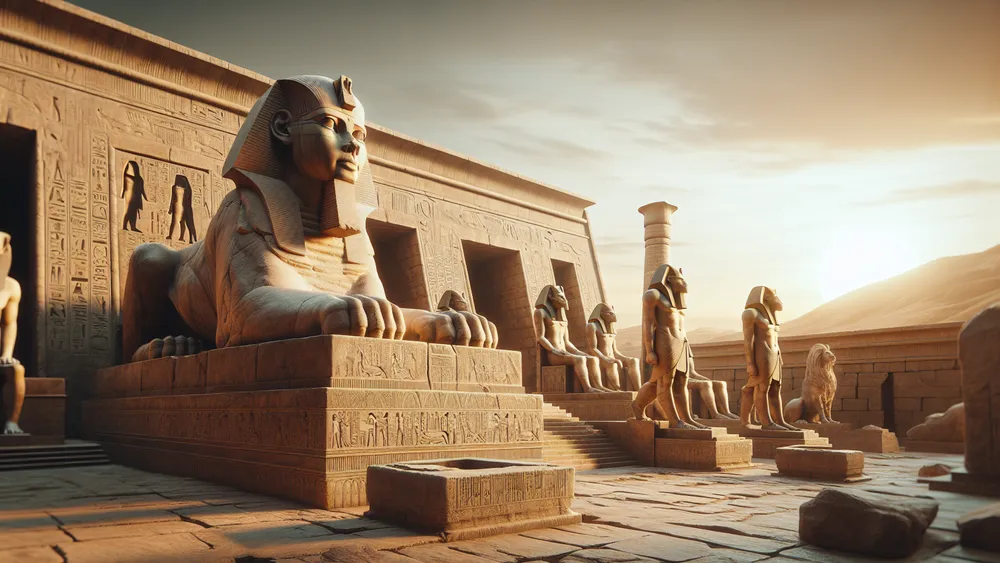
Just like today’s monuments honor key people or events, in ancient Egypt, lion statues were made to honor gods and pharaohs, showing their link to the divine and their role as realm protectors.
Several famous lion statues show the greatness and skill of ancient Egyptian art. The Great Sphinx of Giza, with a lion’s body and a person’s head, is maybe the most well-known, showing the pharaoh’s strength and wisdom. At the Temple of Karnak, lion statues stand as watchful guards of the holy area. Techniques to make these sculptures were advanced for that time. They involved careful carving from large stone blocks, often granite or limestone. Tools like copper chisels, stone hammers, and abrasive sand were used to create the fine details and smooth finishes of these grand art pieces. Examples include:
- The Great Sphinx of Giza
- Lion statues at the Temple of Karnak
- Lion-headed statues at the Temple of Soleb
Lions in Tombs and Temples
Lion pictures were common in old Egypt tombs and temples. They were both decorations and symbols. These big animals were shown in carvings, statues, and paintings, put in certain spots to guard the entrances and insides of these special places. Like how we use guard dogs or cameras today, people then thought lions kept away bad things and protected the sacred spots.
Their presence showed how important it was to keep the dead’s resting places and the holy sites of gods safe. Lions symbolized power, protection, and being divine guards. They were the pharaoh’s protectors in the afterlife, making sure of their safe journey and rest forever. In temples, lions showed the gods’ and pharaohs’ divine power and their ability to keep bad things away.
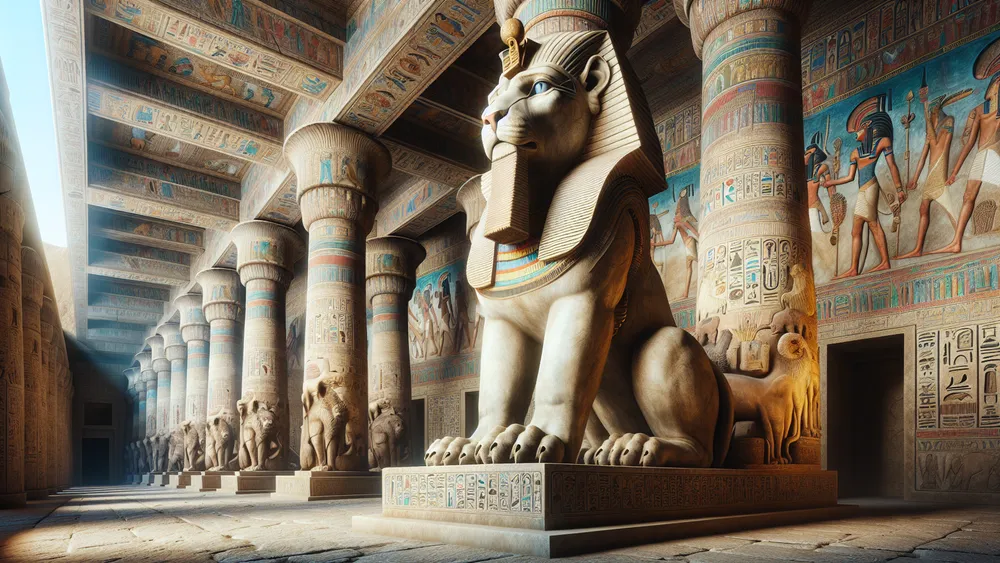
Some known places with lion images are the Mortuary Temple of Hatshepsut, where lion statues are like watchful guardians, and the tomb of Tutankhamun, which has detailed lion designs on different items. These examples show the strong importance of lions in old Egypt’s religious and cultural life.
Lions in ancient Egypt symbolized power, protection, and divine guardianship, playing a crucial role in safeguardingsacred places and representing the pharaoh’s protectors in the afterlife.
Lions in Egyptian Stories and Myths
To really understand how important lions were in old Egypt, we need to look at their roles in the many stories and myths of Egypt.
Myths and Legends with Lions
Lions show up mainly in many stories and myths of Egyptian myths, often standing for power, protection, and divine anger. One of the most known lion figures is the goddess Sekhmet who has a lioness’s head. Sekhmet, called the “Powerful One,” had a very important role in the Eye of Ra myth.
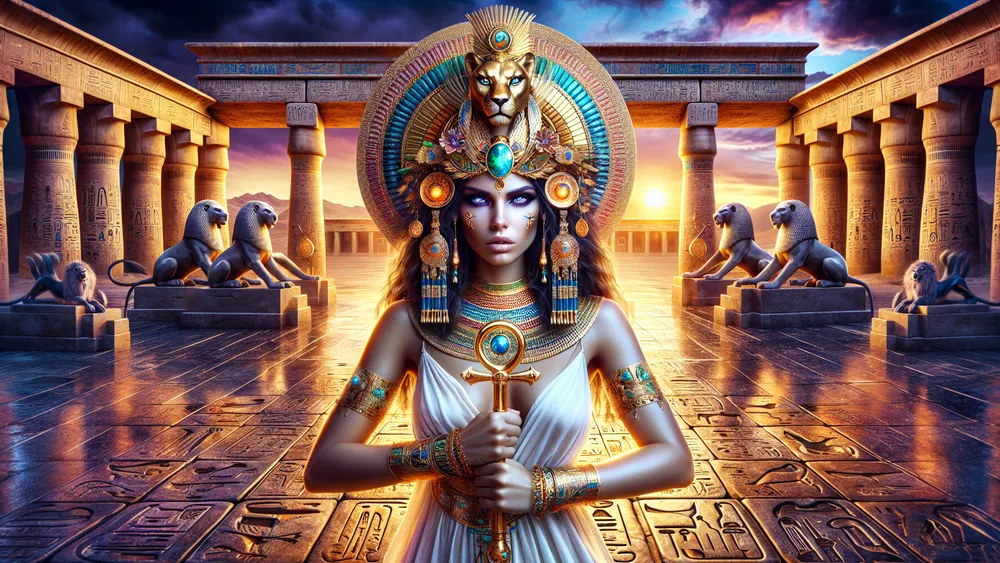
The story says Ra, the sun god, sent Sekhmet to punish people for being bad. She was very fierce and harmful, like a mother lion protecting her young ones. But, her anger got so strong that Ra had to step in and tricked her into drinking a mix of beer and pomegranate juice, confused for blood by her, calming her and saving people from destruction.
Also, besides Sekhmet, lions have important parts in Ra’s nightly trip through the underworld. Every night, Ra would go through the underworld, facing many dangers and challenges, until he was reborn at dawn. Lions were seen as protectors during this tough journey, showing strength and watchfulness. They kept Ra safe from chaotic forces, making sure he passed safely and the world order kept going.
This nightly trip is like facing daily problems to grow stronger each day. Lions in these stories show their role as symbols of protection and strong survival in old Egyptian beliefs.
Lions in Egyptian Folklore
In Egyptian folklore, lions played important parts in common stories. They worked as symbols in moral and caution tales. These grand animals were often shown as examples of strength, bravery, and guarding, much like animals used in modern stories to teach lessons.
One story tells of a lion who, even with his scary look, shows mercy to a smaller animal, teaching why being kind and humble matters. Another story might have a lion who keeps watch over a sacred treasure, showing why being alert and the results of being greedy are important.
These stories were fun but also taught ethics and social values to people hearing them. This kept the lion’s position as a respected and honored figure in Egyptian life.
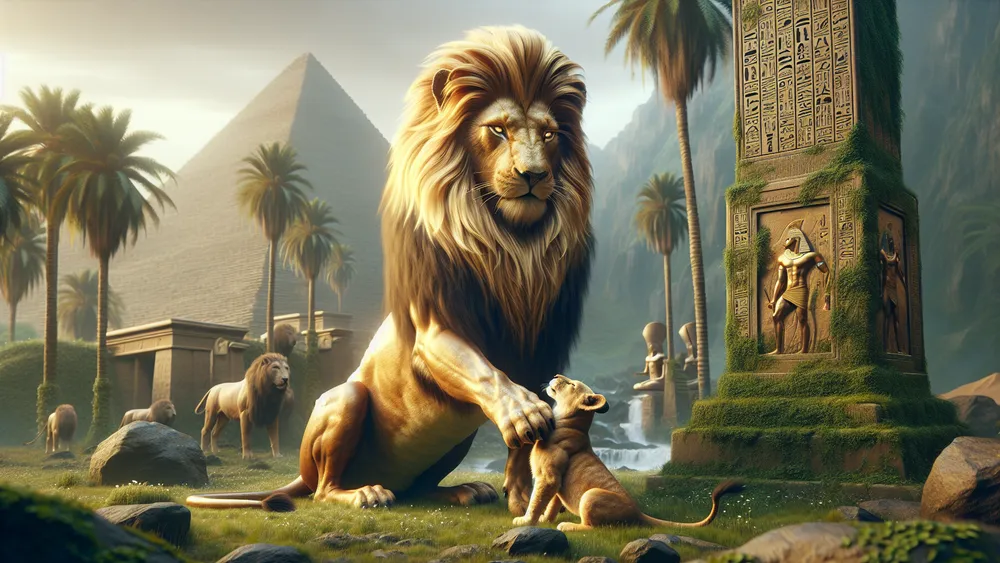
Lions’ Legacy in Modern Egypt
Knowing the old and story-based importance of lions in old Egypt helps us see their lasting impact in modern Egypt.
Ancient Lion Symbols in Today’s Egypt
Old lion symbols still affect modern Egyptian life in many deep ways. Lions, respected for being signs of power, safety, and kingship in old Egypt, still have an important place in modern Egypt. This lasting impact is clear in lion pictures in Egyptian art, books, and media today. Like, modern Egyptian artists often use lion designs to show strength and history.

And, lions show up in modern stories, where they stand for bravery and holding on. In media, lions are often in movies and shows talking about Egypt’s rich history and culture, connecting the past with now. Also, lion pictures are in public places and national signs. Lions are big in many public statues around Egypt, showing the country’s lasting power and big history.
Like, the famous lion statues at the Qasr El Nil Bridge in Cairo prove the lasting power of old lion symbols. Lions are also in logos for Egyptian firms, showing things like being leaders and safety. These modern uses show how set these old symbols are in Egyptian people’s minds, still giving ideas and affecting today’s culture.
FAQs
1. What is the significance of the lion in ancient Egyptian mythology?
The significance of the lion in ancient Egyptian mythology lies in its representation of power, protection, and royalty.
2. How were lions depicted in ancient Egyptian art and architecture?
Lions were depicted in ancient Egyptian art and architecture as symbols of power, protection, and royalty, often appearing in statues, reliefs, and temple decorations.
3. What are some famous myths and legends involving lions in Egyptian mythology?
Some famous myths and legends involving lions in Egyptian mythology include the story of the lion-headed goddess Sekhmet and her role in the myth of the Eye of Ra.
4. How has ancient lion symbolism influenced modern Egyptian culture?
Ancient lion symbolism has influenced modern Egyptian culture by continuing to represent power, protection, and royalty in contemporary art, literature, and media.

